
|
Atmospheric Mercury Measurements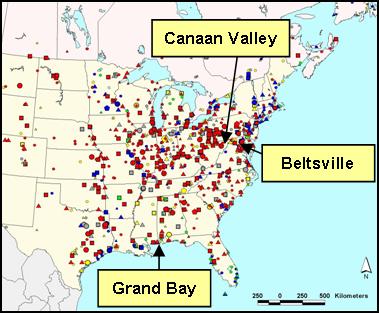 Location of ARL's three long-term speciated atmospheric mercury measurement sites, overlain on a map of large mercury point sources (for 2002) in the United States and Canada based on data from the U.S. EPA and Environment Canada. Click here for enlarged version of this figure, including a legend for the mapped emissions sources, as a PDF or a Powerpoint file.Overview:In conjunction with the National Atmospheric Deposition Program's (NADP) Atmospheric Mercury Initiative, ARL operates three stations for the long-term, research-grade monitoring of concentrations of mercury species and other trace pollutants in the atmosphere:
The goals and objectives of the measurements are the following:
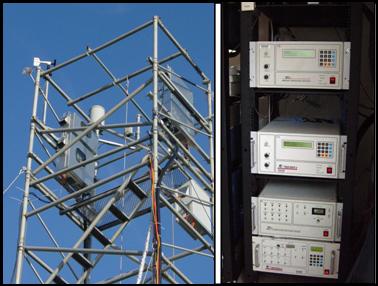 (a) Measurement tower at Grand Bay NERR, showing two sets of Tekran reactive gaseous mercury and fine particulate mercury collection units; (b) Mercury measurement equipment in climate-controlled trailer adjacent to tower.At each site, ambient air concentrations of gaseous elemental mercury, reactive gaseous mercury, and fine particulate mercury are measured. In addition, ambient air concentrations of trace gases (e.g., sulfur dioxide, nitrogen oxides, carbon monoxide, ozone) are measured. Meteorological parameters such as temperature, humidity, precipitation, wind speed and direction are also measured. Wet deposition measurements are being made following Mercury Deposition Network (MDN) protocols at the Beltsville site by collaborators (Univ. of MD, State of MD) and MDN sites are planned to be implemented at the Grand Bay and CVI sites as resources permit. Deposition in precipitation is quantified through chemical analysis of collected rain and snow samples. In addition to the three long-term sites noted above, a number of short-term mercury measurement campaigns have been carried out, including the following: Cove Mtn, TN (Summer 2002); Gulf of Mexico (Ship) (Summer 2003); Oxford and Wye, MD (Summer 2004); Harcum, VA (Summer 2005); Houston, TX (Summer 2006). Grand Bay NERR, MS: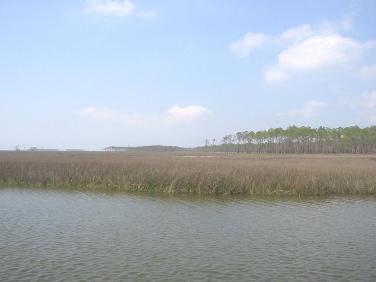 View from Grand Bay NERR atmospheric mercury measurement tower.Speciated ambient mercury measurements began at the Grand Bay NERR in September 2006. Mercury measurements at this time were made with a single Tekran instrument suite at a temporary location (30.4294o N, -88.4277o W). In 2007, a second Tekran instrument suite was added and the site location was moved to its permament location on FWS Grand Bay National Wildlife Refuge property adjacent to the Grand Bay NERR (30.412o N, -88.404o W). ARL is grateful to NOAA National Ocean Service's National Centers for Coastal Ocean Science for assistance in purchasing measurement equipment for the site. Summaries of activities and measurements at the Grand Bay NERR site are available [1], [2], [3], [4], [5]. The two co-located mercury measurement systems at the site are particularly useful in that they:
Beltsville, MD: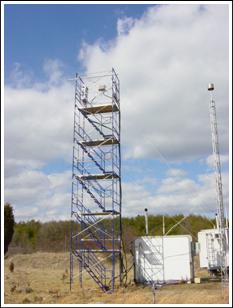 Atmospheric measurement monitoring tower at Beltsville MD.The U.S. EPA Clean Air Markets Division (CAMD) and the NOAA Air Resources Laboratory (ARL) have established a comprehensive atmospheric mercury monitoring site (39.0284o N, -76.8172o W) near Beltsville, Maryland, on the campus of the USDA Beltsville Agricultural Research Center, and bordering the U.S Fish and Wildlife Service's Patuxent National Wildlife Refuge (NWR). The site is located on parkland embedded within a suburban portion of the Washington, DC metropolitan area, and is representative of much of the semi-urban nature of the Chesapeake Bay watershed. Other collaborating organizations at the site include the State of Maryland Department of Natural Resources and the University of Maryland. The Howard University Atmospheric Observatory, a multi-agency research facility for the study of atmospheric physics and chemistry, lies approximately 5 km to the northwest. The Beltsville site includes two Tekran speciation systems measuring Hg0, RGM, and Hg(p), like the Grand Bay NERR site, providing comparable quality assurance, continuity and other benefits. Mercury compounds, ancillary trace gases (SO2, O3, CO, NO, NOy), and meteorological parameters are measured at a height of 10 meters to minimize local surface effects. The site also hosts measurements under the EPA CASTNet, NADP/NTN (major ions in precipitation) and MDN (mercury wet deposition) programs. These existing co-located measurements were an important factor in choosing the Beltsville location for enhanced mercury monitoring. Summaries of activities and measurements at the Beltsville site are available [3],[5],[6]. Canaan Valley: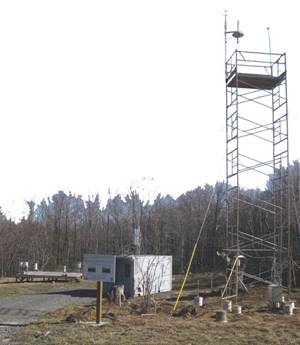 Mercury measurement site at Canaan Valley, WV.The mercury monitoring site at Canaan Valley, operating since 2005, is a contributing and founding station (1 of 5) to the National Atmospheric Deposition Program Consortium (NADP) National Mercury Initiative for estimating mercury (Hg) wet/dry deposition rates with continuous speciation measurements and precipitation sampling. It is the only station of its kind in West Virginia. The main purpose of this site is to monitor atmospheric Hg species, and to develop techniques to examine the fluxes of Hg species at the air-surface interface. CVI also operates Climate Reference Network, Ameriflux, Global Energy and Water Cycle Experiment (GEWEX), and AIRMoN sites in Canaan Valley. The facilities and datasets are utilized by NOAA, EPA-sponsored researchers, and university researchers and graduate students performing environmental Hg studies. Soils and sediment were collected and analyzed by Duquesne University in July 2005. CVI plans to repeat the exercise with the addition of biota in July 2008 with researchers from the University of Maryland's Appalachian Lab. Other collaborators are Jesse Bash (EPA RTP), Steve Lindberg (EPA STAR), NOAA ARL, ORNL, West Virginia University, and Penn State. Summaries of mercury monitoring activities at CVI are available [5], [7]. Documents available for viewing or download(referred to by number in the narrative above)
|
|
|
|